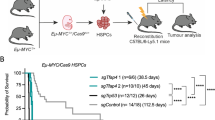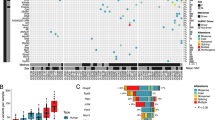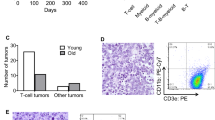Abstract
λ-MYC-induced mouse Burkitt lymphoma (BL) harboring the shuttle vector pUR288, which includes a lacZ reporter gene to study mutagenesis, was employed to assess genomic instability associated with MYC deregulation. The frequency of lacZ mutations in lymphomas was elevated only 1.75-fold above that in normal tissue, indicating that mouse BL does not exhibit a phenotype of hypermutability. However, the nature of lacZ mutations was strikingly different in normal tissues and lymphomas. While point mutations comprised approximately 75% of the mutations found in normal tissues, apparent translocations, deletions and inversions constituted the majority of mutations (∼65%) in lymphomas. Genomic instability in mouse BL thus seems characterized by a preponderance of illegitimate genetic rearrangements in the context of near-background mutant frequencies. SKY analyses of cell lines from primary BL tumors revealed substantial changes in chromosomal structure, confirming the lacZ studies. Bi-allelic deletions of the tumor suppressor p16Ink4a were detected in six out of 16 cell lines, illustrating cellular selection of advantageous mutations. Together, these approaches indicate that MYC may contribute to lymphomagenesis through the dominant mutator effect of inducing chromosomal instability. The results further suggest that a phenotype of hypermutability (elevated mutant frequency) may not always be required for oncogenesis to occur.
This is a preview of subscription content, access via your institution
Access options
Subscribe to this journal
Receive 50 print issues and online access
$259.00 per year
only $5.18 per issue
Buy this article
- Purchase on Springer Link
- Instant access to full article PDF
Prices may be subject to local taxes which are calculated during checkout



Similar content being viewed by others
References
Baross-Francis A, Andrew SE, Penney JE, Jirik FR . 1998 Proc. Natl. Acad. Sci. USA 95: 8739–8743
Boerrigter ME, Dolle ME, Martus HJ, Gossen JA, Vijg J . 1995 Nature 377: 657–659
Buettner VL, Hill KA, Nishino H, Schaid DJ, Frisk CS, Sommer SS . 1996 Oncogene 13: 2407–2413
Cole MD, McMahon SB . 1999 Oncogene 18: 2916–2924
Coleman AE, Ried T, Janz S . 2000 Genes Chromosomes Cancer 29: 70–74
Davis CD, Dacquel EJ, Schut HA, Thorgeirsson SS, Snyderwine EG . 1996 Mutat. Res. 356: 287–296
Eischen CM, Weber JD, Roussel MF, Sherr CJ, Cleveland JL . 1999 Genes Dev. 13: 2658–2669
Eischen CM, Woo D, Roussel MF, Cleveland JL . 2001 Mol. Cell. Biol. 21: 5063–5070
Felsher DW, Zetterberg A, Zhu J, Tlsty T, Bishop JM . 2000 Proc. Natl. Acad. Sci. USA 97: 10544–10548
Gossen JA, de Leeuw WJ, Tan CH, Zwarthoff EC, Berends F, Lohman PH, Knook DL, Vijg J . 1989 Proc. Natl. Acad. Sci. USA 86: 7971–7975
Jakubczak JL, Merlino G, French JE, Muller WJ, Paul B, Adhya S, Garges S . 1996 Proc. Natl. Acad. Sci. USA 93: 9073–9078
Kohler SW, Provost GS, Fieck A, Kretz PL, Bullock WO, Putman DL, Sorge JA, Short JM . 1991 Environ. Mol. Mutagen. 18: 316–321
Kovalchuk AL, Qi CF, Torrey TA, Taddesse-Heath L, Feigenbaum L, Park SS, Gerbitz A, Klobeck G, Hoertnagel K, Polack A, Bornkamm GW, Janz S, Morse HC . 2000 J. Exp. Med. 192: 1183–1190
Liyanage M, Coleman A, du Manoir S, Veldman T, McCormack S, Dickson RB, Barlow C, Wynshaw-Boris A, Janz S, Wienberg J, Ferguson-Smith MA, Schröck E, Ried T . 1996 Nat. Genet. 14: 312–315
Loeb LA . 1991 Cancer Res. 51: 3075–3079
Moore JK, Haber JE . 1996 Nature 383: 644–646
Mushinski JF, Mai S . 2002 Crit. Rev. Oncog. In press
Roth DB, Wilson JH . 1988 Genetic recombination Kucherlapati R and Smith GR (eds) Washington, DC: American Society for Microbiology pp. 621–654
Tomlinson I, Bodmer W . 1999 Nat. Med. 5: 11–12
Acknowledgements
We wish to thank Dr Jan Vijg, UT at San Antonio, for providing pUR288 mice, Drs Michael Boerrigter, Leven, Inc., Martijn Dollé, UT at San Antonio, and Klaus Felix, NCI, for advice on the pUR288 mutagenesis assay, Danny Wangsa and Viktor Janz, Department of Genetics, NCI, for help with the SKY analysis, Dr Lionel Feigenbaum, SAIC, for generating E-MYC mice, and Wendy DuBois and Taryn Stelter for animal husbandry. These studies were supported in part by a NCI Intramural Research Award to S Janz.
Author information
Authors and Affiliations
Corresponding author
Rights and permissions
About this article
Cite this article
Rockwood, L., Torrey, T., Kim, J. et al. Genomic instability in mouse Burkitt lymphoma is dominated by illegitimate genetic recombinations, not point mutations. Oncogene 21, 7235–7240 (2002). https://doi.org/10.1038/sj.onc.1205697
Received:
Revised:
Accepted:
Published:
Issue Date:
DOI: https://doi.org/10.1038/sj.onc.1205697



